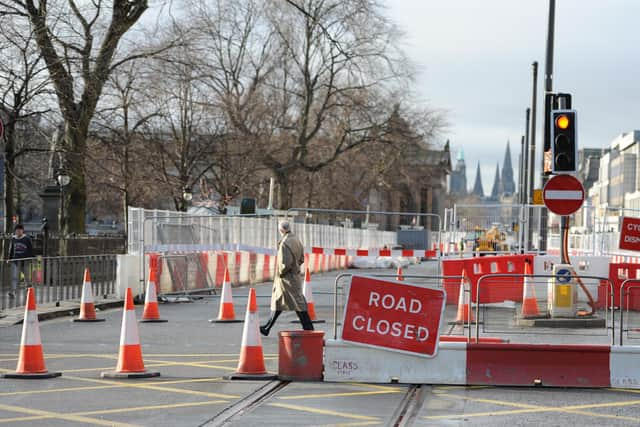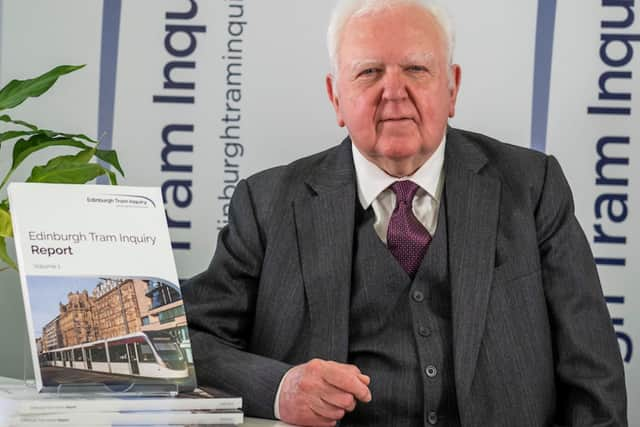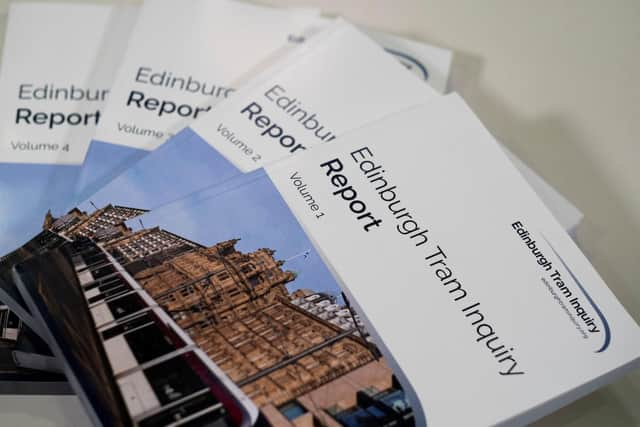Edinburgh tram inquiry: What did Lord Hardie have to say about who was to blame for tram fiasco?
and live on Freeview channel 276
Lawyers, politicians and other will still be digesting Lord Hardie’s 959-page report on the Edinburgh tram inquiry which was finally published on Tuesday, September 19, nine years after the inquiry was set up.
So what were the former Lord Chancellor’s long-awaited findings on what went wrong with the project which turned into an embarrassment for the Capital? What did he have to say about the tram line that ended up much shorter than planned, three years late and millions of pounds over budget?
Here are some of the answers.
Advertisement
Hide AdAdvertisement
Hide Ad

Who does the report blame for the trams fiasco?
Lord Hardie says there was “a litany of avoidable failures” on the part of several parties, but he particularly singles out the city council’s arms-length tram firm TIE (Transport Initiatives Edinburgh), while also heavily criticising city council officials and Scottish Government ministers.
He says TIE did not follow the procurement strategy, which had been designed to manage risk out of the project; mismanaged the project; failed to work collaboratively with either the council or the contractors; and failed to report accurately to the council on progress.
He criticises council officials for misleading councillors on crucial aspects of the project; failing to monitor progress adequately; and failing to protect the interests of the council over the cost. And he says Scottish Government ministers were wrong to withdraw Transport Scotland from direct involvement in the project after June 2007 when the SNP’s plan to scrap the project was defeated in the Scottish Parliament.


What does the report say about the cost of the project?
Lord Hardie notes that the cost of delivering the whole route from the airport to Newhaven had been budgeted at £545 million – with the Scottish Government providing £500m in funding – but after all the rows and delays the final cost reported was £776m for a shortened route from the airport to York Place. However, he says the true price was higher –nearer £835m – once other costs were taken into account, including support for businesses which suffered disruption during the work, a landowner’s compensation claim and the need to borrow to cover the increased bill.
Advertisement
Hide AdAdvertisement
Hide AdDoes he explain why the inquiry itself took so long and cost so much?
When Alex Salmond, who was then First Minister, set up the inquiry in 2014 he said it would be “swift and thorough” – but it has taken nine years and the report comes more than five years after the public hearings finished. Lord Hardie says it took so long because of the volume of material he had to consider – six million emails and other documents had to be sifted – as well as prolonged IT problems, difficulties in obtaining documents, staffing issues, the illness of the inquiry solicitor and the need to issue warning letters to people criticised in the report and subsequent redrafting. The cost of the project was more than £13 million but the net cost to the public purse was kept to £8.7 million by using existing public resources.


What are the report’s recommendations?
There are a total of 24 recommendations, the most significant of which is to consider legislation to allow for civil and criminal sanctions against individuals or companies who knowingly submit reports that include false statements to councillors. Lord Hardie also urges the Scottish Government to carry out a review of public inquiries and how to avoid delays in establishing them, perhaps by creating a dedicated unit within the Scottish Courts and Tribunals Service.
And he makes a series of recommendations on future light rail projects, including that if a project relies on design and utilities diversion being completed in advance, negotiations on the infrastructure contract should be delayed until that has been achieved; that risk assessments should be subject of a peer review by external consultants with experience of similar large-scale transport infrastructure projects; and that 20-year-old guidance on optimism bias – the tendency to look on the positive side when assessing projects – should be updated and regularly reviewed.
He also recommends a joint working group between Transport Scotland and council umbrella group Cosla to look at how best to ensure Transport Scotland expertise can be used on projects and urges that minutes are kept of all meetings, discussions and phone calls between ministers and civil servants or council representatives about publicly-funded projects.
Advertisement
Hide AdAdvertisement
Hide AdDoes Lord Hardie criticise individuals in the report?
Some individuals do come in for direct criticism in the report, including former Deputy First Minister John Swinney, whose integrity Lord Hardie calls into question. He says Mr Swinney and a Transport Scotland official tried to obscure the purpose of a phone call between them just before the signing of the mediation deal which brought the project back on track in 2011. Both men denied that the call had been to get Mr Swinney’s approval for the deal, but Lord Hardie rejected their evidence.
He said: “As with all witnesses who gave evidence in person, they testified on oath and their lack of candour calls into question their integrity.” Lord Hardie suggested it showed ministers’ continuing influence on the project despite Transport Scotland’s withdrawal. And he also pointed to Mr Swinney telling TIE chairman David Mackay in 2009 at the time of the dispute over works on Princes Street: “Get it sorted”.
Former Transport Minister Stewart Stevenson is criticised in the report for writing to Edinburgh council leader Jenny Dawe in February 2009, just as the dispute over works on Princes Street was developing, seeking reassurance that there would be early settlement. Mr Stevenson said that in doing so he was “simply trying to make sure my political opposite numbers, in the council, remembered the nature of the commitment we had made to the project”. But Lord Hardie says it was “an overtly party political act”. He added: “It represents nothing more than political point scoring and could serve only to exacerbate matters by raising the tension.”
The city council’s head of legal services Nick Smith is also criticised. Mr Smith sent an email to a new senior officer in 2010 telling him: “Be very careful what info you impart to the politicians as the directors and TIE have kept them on a restricted info flow. Given current sensitivities it is critical that this remains in place.” Lord Hardie says the email made him consider whether misleading reports to councillors were really the result of errors based on inaccurate information from TIE, as claimed, “or the result of a deliberate policy of withholding information”. Lord Hardie said Mr Smith was responsible for a false claim in two 2010 reports to councillors that the outcomes of formal adjudications on disputes between TIE and contractors were “in terms of legal principles, finely balanced”. Lord Hardie says: “Clearly, on occasions, mistakes may occur in the drafting of reports, but that is not the situation because Mr Smith was aware that the statements were untrue.”
Advertisement
Hide AdAdvertisement
Hide AdDame Sue Bruce, former city council chief executive, led the council side in negotiations in September 2011 which secured a final settlement of the dispute with the contractors. But Lord Hardie says because the deal exceeded the authorised spending limit, council officials should have got approval from politicians before signing it. “Officials failed to observe the distinction in roles between them and councillors and strayed into the political arena itself.”
Dame Sue was also at the centre of another criticism by Lord Hardie directed at the council. Despite assurances all relevant material had been passed to the inquiry, the council contacted the inquiry in September 2017 – after the public hearings had begun – to say they had found 13 of Dame Sue’s files relating to trams and in November 2017 a further 16 folders, paper bundles and Dame Sue’s notebooks were discovered during a clear-out of the chief executive’s office.
Lord Hardie comments: “An obvious location for paper files and other documentation kept by the chief executive at the time of the tram project would be her office. The discovery of that material, when her successor was moving out of that office, suggests a superficial approach to the search for relevant material.”
Lord Hardie described former TIE chair and chief executive Willie Gallagher as “not a satisfactory witness” and instanced Mr Gallagher’s insistence that no council meeting had been planned for December 20, 2007, to approve the project and his claim it had been invented by TIE to put pressure on the contractor to make progress in negotiations when there was ample documentary evidence such a meeting was planned.
Advertisement
Hide AdAdvertisement
Hide AdLord Hardie said: "At times it was difficult for me to accept that his unsatisfactory answers were truly the result of poor recollection of events; rather, there were instances where it appeared that he was fabricating evidence or was not being candid in his responses. His answers were often evasive and his evidence at times incredible."
And former TIE commercial director Geoff Gilbert was also described by Lord Hardie as an "unsatisfactory witness" – for what he didn’t say, rather than for what he did. Lord Hardie said: "It was striking how often he responded to questions by saying that he could not remember or could not recall. No other witness to the inquiry has been so afflicted by memory lapse."
Willie Gallagher, TIE chair from 2005 to 2006 and also its chief executive from 2006 to 2008, was also described as ‘not a satisfactory witness’.
Lord Hardie said: "Mr Gallagher was not a satisfactory witness. He had a poor recollection of matters even where they concerned key areas rather than matters of detail.
Advertisement
Hide AdAdvertisement
Hide Ad"At times it was difficult for me to accept that his unsatisfactory answers were truly the result of poor recollection of events; rather, there were instances where it appeared that he was fabricating evidence or was not being candid in his responses. His answers were often evasive and his evidence at times incredible."
Lord Hardie also criticised Mr Gallagher's "poor management that appears to have been driven by unrealistic optimism".